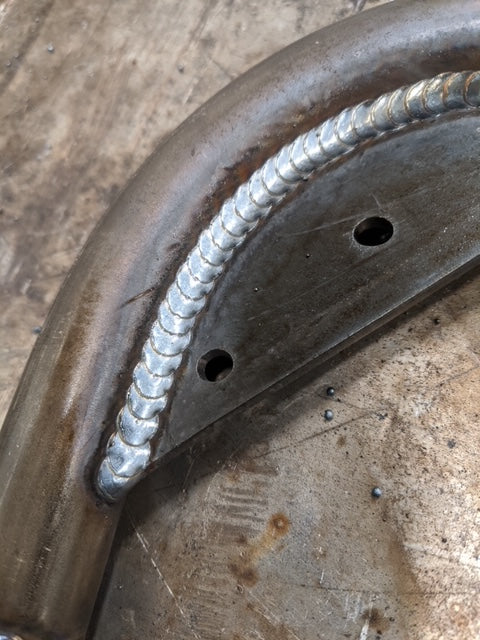Understanding the Heat Affected Zone (HAZ) in Welding: From Basics to Expert Level
By WCR Tools – Your Partner in Precision Welding
Introduction: Why the Heat Affected Zone Matters
When metal is welded, the intense heat of the arc or flame doesn’t just affect the weld bead itself—it also changes the surrounding metal. This surrounding region is known as the Heat Affected Zone (HAZ).
The HAZ is not melted like the weld metal, but it undergoes thermal cycles that alter its microstructure, hardness, toughness, and residual stress levels. Understanding the HAZ is critical because it can make or break the structural integrity of a welded component.
Whether you’re a beginner learning welding basics or an experienced fabricator optimizing weld quality, mastering the science of the heat affected zone will help you:
-
Prevent cracking and distortion
-
Improve weld strength and durability
-
Select the right welding tools, techniques, and consumables
1. Beginner’s Guide to the Heat Affected Zone
What Is the Heat Affected Zone?
In simple terms, the Heat Affected Zone is the band of base metal around a weld that has been heated and cooled but not melted. While it remains solid during welding, the temperature changes can significantly modify the grain structure of the metal.
Key points for beginners:
-
The HAZ is located between the fusion zone (melted weld bead) and the unaffected base metal.
-
It is visible to the naked eye—Look for the discoloration that flares off the weld. It In steels it will conclude with a small set rainbow lines
-
Its properties depend on welding heat input, cooling rate, and material composition.
Why it matters:
Even though it’s not part of the weld metal, the HAZ can be the weakest point if not properly controlled.

You can clearly see the HAZ(Heat affected Zone) in this race car suspension component I welded up.
2. The Science Behind the HAZ
How Heat Changes Metal
When welding, the heat input causes:
-
Grain growth – Higher temperatures cause larger grains, reducing toughness.
-
Phase transformations – Steel can transform between ferrite, pearlite, martensite, and other phases depending on temperature and cooling speed.
-
Residual stresses – Uneven heating and cooling can introduce tensile stresses, leading to cracking.
Example in Carbon Steel:
-
Slow cooling may produce soft pearlite or ferrite.
-
Rapid cooling may create hard martensite, increasing brittleness.
3. Factors Affecting the Heat Affected Zone
The characteristics of the HAZ are influenced by:
a. Welding Process
-
Arc Welding (MIG, TIG, Stick) – Moderate to high heat input.
-
Oxy-Acetylene Welding – Broader heat spread, larger HAZ.
-
Laser and Electron Beam Welding – Narrow, precise HAZ due to concentrated heat.
-
Friction Stir Welding – Lower temperatures, minimal HAZ.
b. Heat Input
Formula:
Higher heat input → wider HAZ.
Generally speaking in steel welding, you will want to keep the HAZ as small as possible to reduce the stresses and issues associated with the chemical changes in the HAZ.
c. Material Type
-
High-carbon steels – Prone to hard, brittle HAZ.
-
Stainless steels – Risk of chromium carbide precipitation (sensitization) in the HAZ.
-
Aluminum alloys – Loss of precipitation hardening in HAZ.
d. Cooling Rate
-
Faster cooling → harder, more brittle HAZ.
-
Slower cooling → softer, more ductile HAZ.

Can you spot the HAZ on this tube steel bumper?!
4. Common Problems in the Heat Affected Zone
-
HAZ cracking – Often from residual stress and brittle microstructures.
-
Loss of toughness – Due to grain coarsening.
-
Sensitization – In stainless steels, reduced corrosion resistance.
-
Soft zones – In heat-treatable alloys like aluminum.
5. Controlling and Optimizing the HAZ
To ensure weld quality, professional welders control the HAZ by:
Preheating
-
Slows cooling rate
-
Reduces residual stresses
-
Prevents formation of brittle phases
Post-Weld Heat Treatment (PWHT)
-
Relieves stress
-
Refines grain structure
-
Restores ductility
Proper Welding Parameters
-
Lower heat input when possible. This is always going to be your main method for keeping your HAZ to a reasonable size.
-
Controlled travel speed
-
Optimized filler materials
Using the Right Tools
6. Expert-Level Insights: Advanced Metallurgy of the HAZ
The HAZ can be subdivided into:
-
Coarse-Grained HAZ (CGHAZ) – Closest to weld, largest grains, weakest toughness.
-
Fine-Grained HAZ (FGHAZ) – Smaller grains, better toughness.
-
Intercritical HAZ (ICHAZ) – Partially transformed region, may contain mixed microstructures.
-
Subcritical HAZ (SCHAZ) – Lowest temperature exposure, may temper existing structures.
Advanced analysis involves:
-
Hardness testing across weld cross-section
-
Optical microscopy and scanning electron microscopy
-
Thermal simulations to predict microstructural changes
7. Final Takeaways
The heat affected zone is more than just a side effect of welding—it’s a critical zone that determines whether your weld will last decades or fail prematurely. By understanding its metallurgy, formation, and control methods, welders can consistently produce high-quality, defect-free joints.

Try to make your HAZ as small as possible while still maintaining correct weld penetration. It will always be present but remember that good heat control makes for pretty and strong welds.
